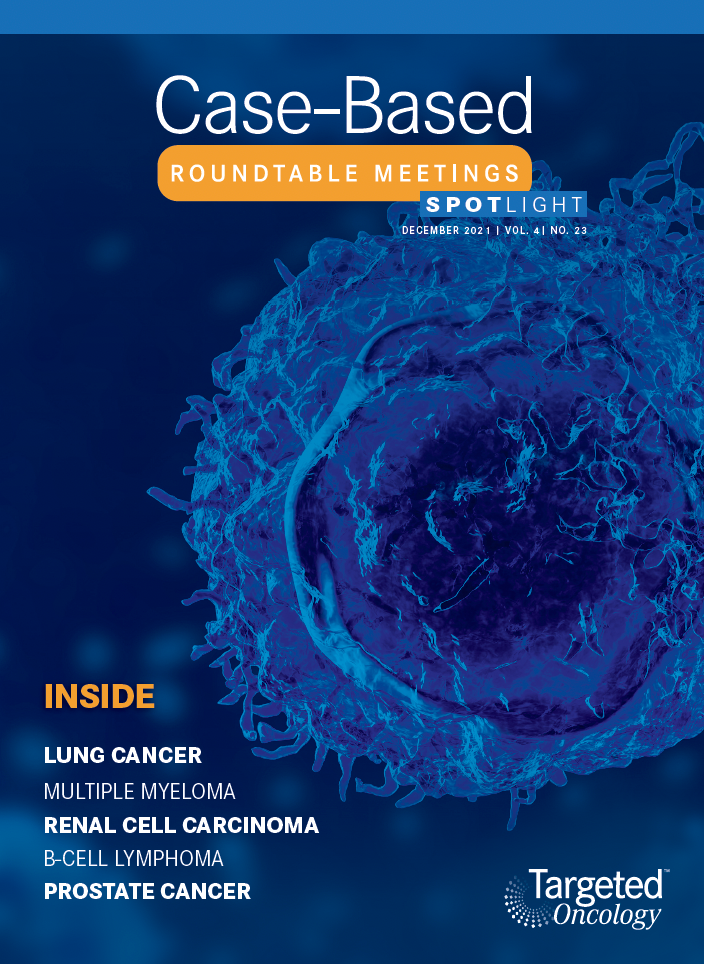Roundtable Discussion: Usmani and Participants Review Using Transplant and Combination Therapy in a Patient With Newly Diagnosed Multiple Myeloma
A 51-year-old man presented with worsening fatigue on exertion and pallor with an ECOG performance score of 2 and was diagnoses with stage II standard-risk multiple myeloma.
Saad Zafar Usmani, MD, MBA
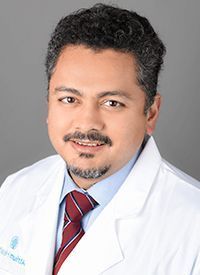
During a Targeted Oncology Case-Based Roundtable event, Saad Zafar Usmani, MD, MBA, chief, Plasma Cell Disorders Program, director, Clinical Research in Hematologic Malignancies, Levine Cancer Institute, Atrium Health, discussed the case of a 51-year-old patients with newly-diagnosed multiple myeloma with 6 peers.
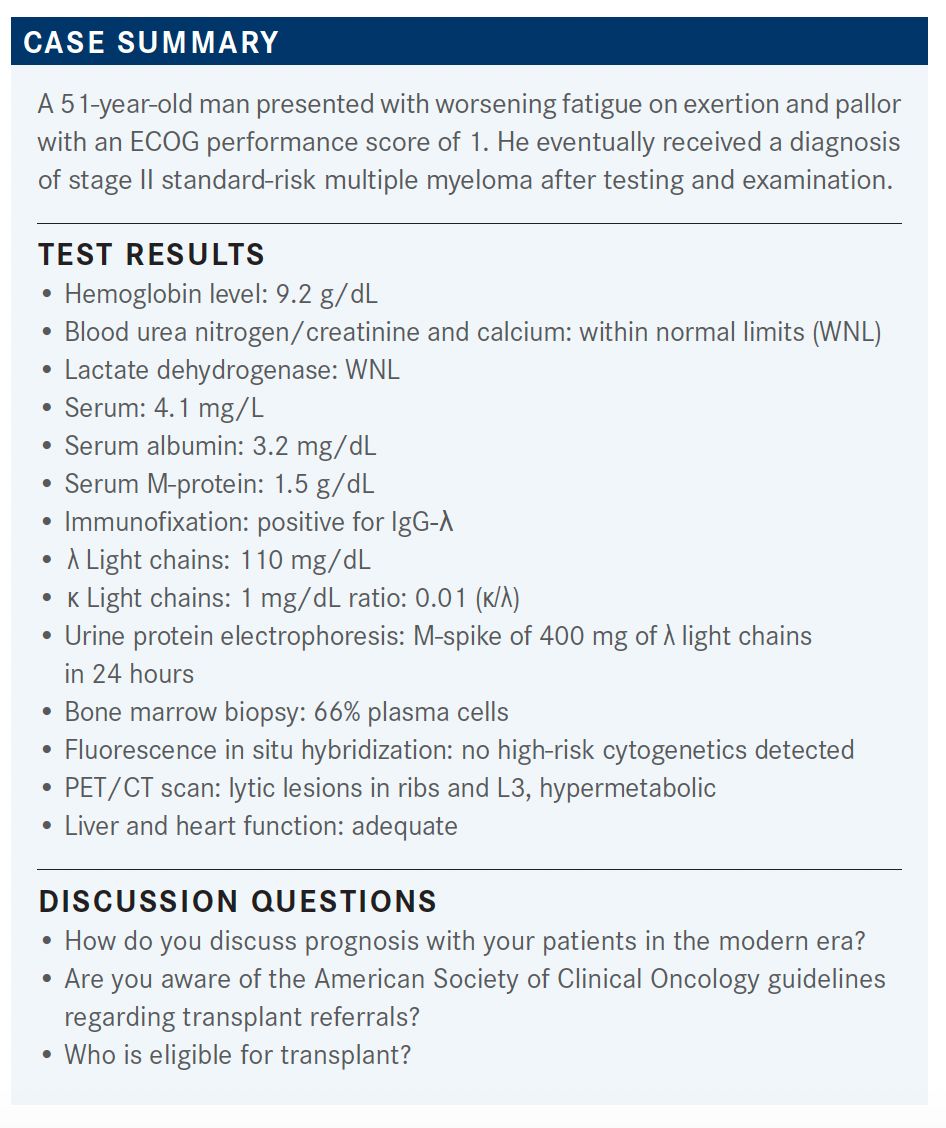
USMANI: How do you discuss the prognosis with your patients? We can use this patient’s case as an example.
MORAVINENI: From my perspective, you want to know which patient you are talking to, how educated they are, [and] how much they can understand. Are there any other family members with cancer? The psychosocial aspect of this, to me, is to think about how little or how [extensively] I should [go into detail] and how much the patient is interested to know about the prognosis. Some patients may not want to know at all at this point, but who is interested in talking about incurable cancer? Great benefit is out there, great therapies, expectation of several years of survival. All we need is confidence, literacy, and [adherence] that I will integrate and start from that point.
RUDOLPH: You know the prognosis clearly through cytogenetics. I don’t know that staging carries too much weight in this day and age. As far as transplant eligibility, that’s a tougher question. I think it really depends upon the transplanter. Everybody has different age criteria, so I leave it entirely in the hands of the transplanter. I’ve had some that are aggressive, that want to offer transplant to a patient in their 80s, and then there are some that’ll stop at patients in their mid-70s.
THOMAS: I agree with Dr Moravineni when he said some patients want to know and some don’t want to know. So generally, when I first make a diagnosis, I don’t go into prognosis too much unless they push me, and if they do, then I give them real-world perspective-type things. I’ll say something like, “When I first was in fellowship in the ’90s, patients generally lived 2 to 3 years, and now we’ve come a long way with the treatments. Now an average patient may live 5 years, but I have many patients live over 10. It depends on the aggressiveness of your treatment, your overall health, that type thing.” So that’s usually how I approach it.
USMANI: I think those are very good points. One of the questions here is how you define young, but regardless of the age, I think different patients may be in a very different place emotionally as well—trying to deal with the diagnosis. So you’re absolutely right. You have to play this by situation and can’t front-load the patients with data only.
You have to do this by feeling, and that’s what makes our profession so interesting and filled with humility at every step. Dr Rudolph, I think you made good comments about engaging the transplant physician closest to you, whoever you send a person [to], who makes that determination many times.
Someone who is like this 51 year old, would you think of them as a young patient? How do you define a young patient with multiple myeloma, and what would be your criteria to send someone for a transplant discussion at a transplant center?
MORAVINENI: This patient has at least a standard-risk disease, definitely not a high-risk disease—51 years old with no critical organ dysfunction. Most likely the patient would be motivated. Then the response to initial treatment, I also expect to be north of 90%. So I feel...all the criteria are here for this patient to get longer benefits after the initial induction therapy. I would lead the discussion as steps: what risk and stage, what are our treatment options, and which is best to go with, quadruplet or triplet. Talk to the transplant physician, and [find out whether the] patient agrees; most people would, as there’s long-term benefit.
USMANI: I would add that at the age of 51, you could also anticipate this patient to be working full-time as well and trying to get back being productive again for as long as they can. So I think to your point, the level of motivation would probably be much higher.
XIA: With the bone marrow transplant, there’s no overall survival [OS] benefit, only progression-free survival [PFS] benefit. With so many new medications coming up, even though the person is young, do you think we should send everybody with good performance status?
USMANI: Every preclinical trial that we’ve done—I’ve been hearing this line in so many presentations since I was a trainee. Now that we have novel agents in multiple myeloma, is there still a role for stem cell transplantation? I’ve been hearing that for over 2 decades, but each clinical trial we’ve done demonstrates PFS benefit in favor of stem cell transplant and using high-dose melphalan. During this period, we continue to have an improvement in OS.
When we look at the 6-, 7-, or 8-year OS, it won’t be any different for a disease that has a median of 10 or 12 years of survival now because we keep on moving that needle with addition of treatments on the back end. What’s important to appreciate, however, is not every patient with multiple myeloma will benefit from every drug we have. We lose about 25% to 30% of the patients with each relapse, so there’s an attrition rate. The assumption that you can save up your good drugs for later—many of our patients will never get that good drug. So the approach now is to pick the best options to give the best PFS for your patient at that particular moment in time.
With that in mind, for someone who’s 51 years old who probably wants to go back to his bank job and be as active and productive as he can for 5 or 6 years and not come back for a relapse treatment in 2 or 3 years, I would think about a stem cell transplant for them in that setting. But that’s my view as a myeloma doctor and a transplanter. Some patients may not agree with that at all. They will say, “Can we just collect stem cells and do this later?” I won’t argue with them; I’ll just share my opinion and data with them and then let them decide.
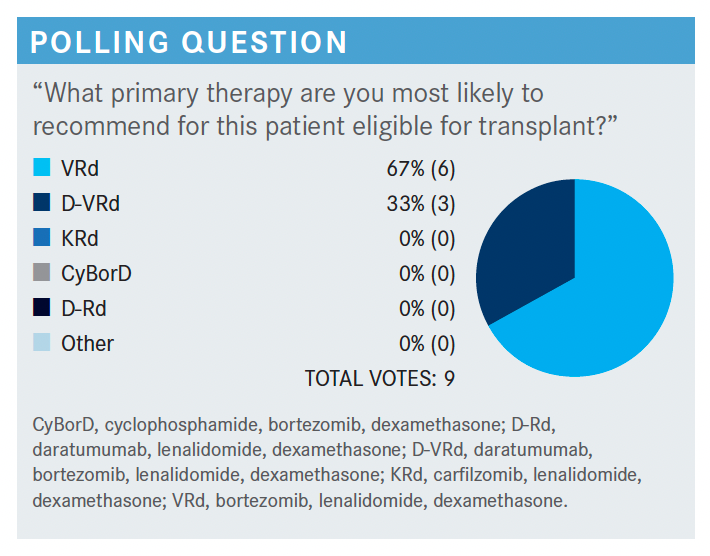
USMANI: It looks like the overwhelming majority is voting for VRd [bortezomib (Velcade), lenalidomide (Revlimid), and dexamethasone]. I would agree with that. I was [1 of the few who voted for] D-VRd [daratumumab (Darzalex), bortezomib, lenalidomide, and dexamethasone] vote because we are early adapters at my program, and since we led the GRIFFIN trial [NCT02874742], we have switched over to D-VRd for induction for most patients.
MORAVINENI: I’m there with you too. [I also voted D-VRd]. I’m impressed with the deep responses, and I don’t feel like saving the daratumumab is the best strategy. I think the first shot is the best shot, and patients may get a great response, a deep response, to start off.
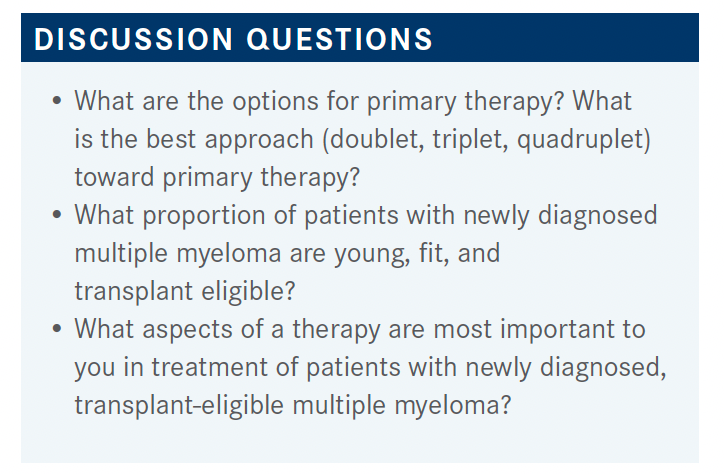
USMANI: What are the options for primary therapy? Dr Moravineni already presented the case about better deepening of response post induction with the addition of daratumumab to the frontline setting, but feel free to [speak up with your opinion].
MORAVINENI: I was very impressed with the high MRD [minimal residual disease] in standard-risk patients like this with the quadruplet [regimen].
USMANI: I think at the end of the first year, the D-VRd posttransplant arm in the GRIFFIN study had around 50% MRD negativity.1 Many people have pointed out that GRIFFIN was a randomized phase 2 study and [that] we need phase 3 data. So there’s a study called PERSEUS [NCT03710603] that’s fully accrued.2 It’s a randomized phase 3 trial with the same design as GRIFFIN, which we are waiting on. I don’t think we will get the report this year, but probably next year.
PARIKH: Have you seen any difficulty in insurance approvals for daratumumab in transplant-eligible patients?
USMANI: No, we have not because daratumumab is approved for frontline therapy with Rd [lenalidomide and dexamethasone] and with VMP [bortezomib, melphalan, and prednisone], as well as with VTd [bortezomib, thalidomide (Thalomid), dexamethasone].3 So we have not seen any issues with insurance, but the way that we are using D-VRd is only for induction. We’re not doing our D-VRd post transplant consolidation or continuing daratumumab as maintenance. We’re trying to get that initial benefit with the 4 cycles of induction, become a bit more consistent in the depth of response you get before stem cell transplant, and then do the same thing that we typically do for a standard-risk patient after that.
What proportion of patients with newly diagnosed myeloma are considered young, fit, and transplant eligible in your practices?
MORAVINENI: I would say about 30% to 40%, and they are in waves from year to year, but in general, at maximum, around 40%.
KATRAGADDA: In my practice, it’s about 40% to 50% [of patients] who are very clearly transplant eligible, but then I would refer some borderline patients who I was not sure would be eligible. Sometimes, if you have an aggressive transplanter, then they would get transplant. So it might go up to 60% depending on those borderline patients.
USMANI: The general consensus I’m getting is somewhere between 35% and 45%—even 50% for some of you.
What aspects of therapy are most important to you in treatment of newly diagnosed disease?
RUDOLPH: We talked about the GRIFFIN trial, and I’ve been torn between doing VRd, as I always did vs adding daratumumab to it. What do you do for the future? There are other options, but daratumumab is a pretty good drug, and you want to get your maximum response, a deep response, in your first line of treatment. I’d love your thoughts [about] VRd vs D-VRd. I’ve started a recent new patient on D-VRd.
USMANI: We thought long and hard about this as well, and that’s why we utilized daratumumab in the induction-therapy setting. With that approach, we are trying to get patients into as good a response as possible during that first year of diagnosis. Now if you look at a standard-risk patient who got D-VRd 5 years ago and is relapsing now, are they refractory to daratumumab? No, they only got it for 4 months and have 4 or more years of PFS benefit from that intervention.
Can you use that again with something else that the patients haven’t seen? Sure you can—you can use daratumumab with Kd [carfilzomib (Kyprolis) and dexamethasone]; you can use it with Vd [bortezomib and dexamethasone]. If they are on lenalidomide maintenance, you won’t be able to use it with lenalidomide, but you would be able to use daratumumab again at that next line of treatment. That’s how we’re thinking about utilizing daratumumab for those standard-risk patients and deepening response during that first year of diagnosis—just the first 4 months of treatment [are] all you’re exposing them to [because] you’re trying to get them into a really good deep response and...to MRD negativity in that first [year] or so.
That’s our approach, and that’s why I was saying we’re not using daratumumab post transplant for consolidation or as part of maintenance treatment in that scenario. But I’m just sharing my own practice and opinion.
As we talked about those standard-of-care regimens, what do you consider standard of care for induction? The vast majority of you have already identified VRd, but do you use any of these other ones? Do you use CyBorD [cyclophosphamide, bortezomib, and dexamethasone] or KRd [carfilzomib, lenalidomide, and dexamethasone] in this setting? What are your thoughts around these other standard-of-care regimens for induction?
RUDOLPH: I have used CyBorD, particularly for a patient who has significant renal insufficiency. It’s a little bit better tolerated than VRd. I have not used some of the other regimens, just pretty much those 2. I’ve also used just lenalidomide and dexamethasone.
THOMAS: I’ve used the CyBorD when they present with acute renal insufficiency to get the renal insufficiency corrected, and then I switch them over generally to VRd. I think you’re persuading me to add daratumumab to the VRd regimen. I’ve been tempted. I had one of the concerns of the other colleagues, which was getting it paid for. I was a little bit concerned about that in the standard-risk patients, and I also think I had the misperception that if you started [daratumumab] early on, you were going to keep going on with it in the maintenance phase. But that’s good to know you only need 4 cycles and then get them into a deep response, transplant, and then do the lenalidomide maintenance. Then you can reuse it, it sounds like, down the road. I do have a patient who’s 88 years old I just started on DRd, and so far, they’ve done very well.
XIA: If this patient presented with severe renal insufficiency—his kidney function is very bad, he needs dialysis, and I don’t think his kidney function would go back to normal or back to low—in this situation, what kind of regimen are you going to put in induction? This is for both transplant-eligible and -ineligible patients. Do you use CyBorD? Or can you use some other thing that is effective?
USMANI: In that situation, if they have standard-risk disease and they’re tolerating CyBorD fine, this is where you fine-tune things for patients. I would keep them on CyBorD in that scenario. If they have high-risk features, I would switch them over to the lower dose of lenalidomide. Lenalidomide is not contraindicated for renal, CKD [chronic kidney disease], or even patients with hemodialysis. You just have to dose it in a different way. You can reduce the dosing as well as the schedule of lenalidomide for those patients. For high-risk patients, that’s the switch that I would make. The subcutaneous formulation of daratumumab would be a reasonable addition to get a good depth of response. Daratumumab plus CyBorD is now approved for systemic amyloid light-chain amyloidosis as well, so it’s an FDA-approved regimen. You can use it to deepen the response for those patients utilizing that indication. We have not had any issues adding daratumumab to CyBorD for our patients either. There are phase 2 data now with an amyloidosis phase 3 trial; you can justify to the insurance companies using it if they raise a concern.
MORAVINENI: How do you typically dose the lenalidomide in the patients with moderate to severe CKD?
USMANI: You would typically go down to 5 mg to start off with. You won’t start with 25 mg. I would typically start with 5 mg every other day; I would go even a bit more conservative than what’s on the package insert and then change it over to the 5 mg every day, the way that the package insert says. But start off with [dosing every other day].
MORAVINENI: That also aligns with their dialysis. I believe that way you’re alternating them in the nondialysis days.
References:
1. Voorhees PM, Kaufman JL, Laubach J, et al. Daratumumab, lenalidomide, bortezomib, and dexamethasone for transplant-eligible newly diagnosed multiple myeloma: the GRIFFIN trial. Blood. 2020;136(8):936-945. doi:10.1182/blood.2020005288
2. Sonneveld P, Broijl A, Gay F, et al. Bortezomib, lenalidomide, and dexamethasone (VRd) ± daratumumab (DARA) in patients (pts) with transplant-eligible (TE) newly diagnosed multiple myeloma (NDMM): a multicenter, randomized, phase III study (PERSEUS). J Clin Oncol. 2019;37(suppl 15):TPS8055. doi:10.1200/JCO.2019.37.15_suppl.TPS8055
3. NCCN. Clinical Practice Guidelines in Oncology. Multiple myeloma, version 2.2022. Accessed October 24, 2021. https://bit.ly/3F1nI79
